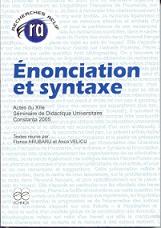Vraisemblance neurocognitive du traitement éclaté du locuteur au sens de la ScaPoLine
Neurocognitive plausibility of the SPEAKER’s split analysis according to the Scandinavian theory of linguistic polyphony (French: ScaPoLine)
Author(s): Anca-Marina VelicuSubject(s): Language and Literature Studies
Published by: Editura Echinox
Keywords: -
Summary/Abstract: Our main concern, in this paper, is the distinction between the “speaker of the (current) utterance” and the “textual speaker”, distinction that plays a crucial role in the Scandinavian theory of linguistic polyphony (French: ScaPoLine), in the sense of Henning Nølke. We actually are going to confront it to a (highly) tentative neural modelling of the grammatical category /PERSON/ which integrates, as observational hypothesis, Benveniste’s classical approach of personal pronouns. This attempt to realistically define not the notion of SPEAKER (as prominent person of the dialogue), but its possible grammatical(ized) counterpart (the formal feature [+speaker]) will borrow most of its explicative tools, on the neurolinguistics side, from the radical connectionism (in the veine of Sydney Lamb’s Pathways of the Brain (1999)), and from Antonio Damasio’s split analysis of the “core self” vs “autobiographical self” (The Feeling of What Happens: Body and Emotion in the Making of Consciousness (1999)), while being consistent, from an analytical point of view, with Noam Chomsky’s “checking theory” (The Minimalist Program, 1995).
Journal: Recherches ACLIF: Actes du Séminaire de Didactique Universitaire
- Issue Year: 2006
- Issue No: 03
- Page Range: 255-278
- Page Count: 24
- Language: French

